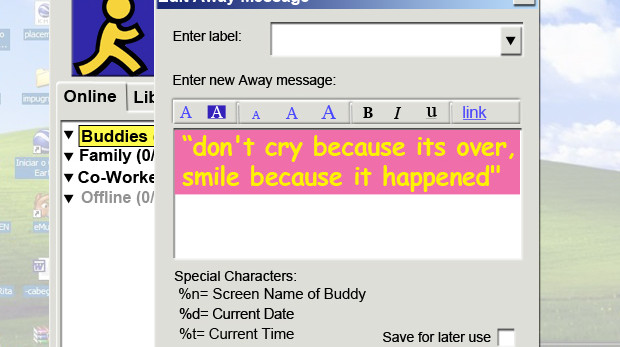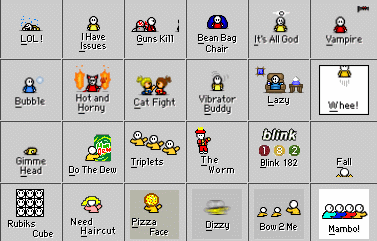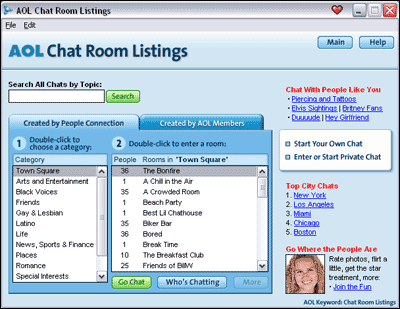RIP, AIM: Remembering how we used to talk on the internet
A eulogy for AOL Instant Messenger, and how it changed the way we talk about games and everything else.

Do you remember all the souls you've lost to the internet? Those incidental friendships, forged in IRC clients, Newgrounds forums, 40-man Ragnaros wipes, scattered across the globe when the web was young? They came into your life and played Fall Out Boy over Ventrilo. They came into your life and disappeared forever. Do you remember when snapping a selfie required a frustrating tangle of mechanical coercion, but it was worth it to show them your face? When real-life names were rarefied information shared exclusively through digital blood pacts? AIM shut down today, and the only thing I can think about is how all of those people still exist somewhere, perhaps exploring the same pit in their stomach that I am.
If you were on AIM, you probably remember how once upon a time those bonds felt illegal.
AIM belongs to all of us. As a pioneering force of internet communication, anyone born in the early '90s or late '80s has spent some time on the platform. As a 26-year old, I'm crucially aware that my appreciation for the prodigal instant messenger is colored by a nostalgia that has nothing to do with the service itself. It was simply the medium of choice to grouse about homework, The Decemberists, girls I liked, and the rest of my random bullshit.
But I do believe that there's a special union between AIM and people who grew up playing games, or at least came of age on the internet with people who played games. The early millennium revolutions in online multiplayer pitted us together and asked us to collaborate, so of course we carried those early internet accords to their logical extremes—talking all night in lonely chat boxes about what's cool, what sucks, and how easy it is to relate. In 2017, the web feels less like something I approach for those connections, and more like an overwhelming ennui that I'm constantly trying to outrun. Boston's Kyle Seeley nailed that feeling perfectly with 2015's Emily is Away, and this year's sequel Emily is Away Too—both of which transport you back to the spongy leather office chairs of your parents' computer room.

"AIM was primarily for one-on-one conversations between teenagers. That's how I used AIM, to have a very intimate conversation with another person. Now we have texting and Facebook messenger, but you can use those wherever you are," he says. "You can use those at a concert or while driving. But when you were using AIM, you were sitting down at a computer to talk to people. You had their undivided attention."
Do you remember all the souls you've lost to the internet?
Emily is Away tributes AIM in the only way anyone can—spinning a yarn of disentranced high-school drama that eventually mounts into something deeply sad. The way Seeley presents an old Windows XP desktop, with the hilariously temperamental tastes of your idiot friends revealing themselves in their bios and away messages (until one day they stop logging on entirely) is immediately resonant. We've all had our Emilys. "When you have a conversation on the phone, you spend 10 minutes making small talk," says Seeley. "On AIM you talk to someone for hours. Like eight hours, 10 hours straight. You get all the small talk out of the way in the first hour, and then you're talking about these big teenager questions. Who am I? Who do I want to be? I think AIM was really good at that."
It was always difficult for me to articulate the intimacy I felt with my internet friends to my parents. There were the obvious, mechanical mistranslations; I begged my mother for early exits from countless family dinners that consistently managed to interfere with my guild's crucial Molten Core attempts. But beyond that, there was a certain shame in feeling loved and valued by people I only knew by username. A latent fear that those who did not understand might consider that affection to be false, or even sinister. That's different now, as social media has flattened out our offline/online dichotomy, but if you were on AIM, you probably remember how once upon a time those bonds felt illegal.

Years ago Nina Freeman, level designer at Fullbright and one of the foremost thinkers on love and technology, launched a flat-out covert campaign to get close with one of those friends. She spent months locked in the holy matrimony of Final Fantasy XI and nightly AIM treatises with a boy named Glenn from New York City. Eventually they met, but not before Freeman satisfied her aunt, (who she was staying with) with a fabricated narrative—Glenn was no longer a dude from the internet, now he was just an old family friend who happened to move east. "I was still in high school," says Freeman. "We made up that whole story."
Keep up to date with the most important stories and the best deals, as picked by the PC Gamer team.
That secrecy is immediately familiar to me. AIM was surreptitious, clandestine. A service that belonged to teenagers, sequestered from leering ears and concerned authority figures. As Freeman notes, a screen name was one of the few commodities a young person could fully own. A domain, an aesthetic, a communication channel you could control. It was rare to feel fully untethered from your parents, so you guarded that sliver of liberty with your life.
"I wouldn't hand out [my username] lightly," explains Freeman. "I'd only really do it with people I felt close enough with. It seems sort intimate. It was a 'thing' to add someone on AIM. The expectation would be that if we're adding each other, we're going to chat regularly.… It had a weight to it."
AIM was surreptitious, clandestine. A service that belonged to teenagers, sequestered from leering ears and concerned authority figures.
Cecilia D'Anastasio, senior reporter at Kotaku (and a friend of mine) went a step further. As an 11-year-old, she was already griefing in the multiplayer Flash games she shared with her friends over AIM. I don't think anything sums up the juvenile euphoria of instant messaging quite like using that power to cheat in stakes-free freeware.
"One of the Flash games I discovered was basically Pictionary, but online and with a chat room. One player would etch out an image in a Microsoft Paint-like interface while the chat would dutifully guess at what it could possibly be. It was very wholesome," says D'Anastasio. "That's why my friend June and I were passionate about cheating. We'd join a game on the same team. Over AIM, we'd tell each other what we were assigned to draw, instructing whoever was guessing to wait a solid ten seconds before revealing the answer. It was a riot. We always won."

Over the past decade or so AIM has slowly been replaced with services that de-emphasize traditional internet patois. Gchat and Twitter are all full of real names and faces instead of coded handles and custom-colored text, and logging in to most platforms scarcely takes more than a click on a Facebook icon. For the most part, this is a good thing. Anonymity is one of the scourges of online culture—a de facto institution that continues to cause a lot of people pain. Personally though, I can't help but feel like we've lost something along the way. There was a certain sublimity in typing from behind the guise of a username. It gave way to a feeling that your AIM conversations existed in some sort of permissive, alternative reality, the ideal spot to work up the nerve for swollen 3 am confessions. In 2017 there is no such thing as "IRL" anymore; your internet presence is permanently married to your day-to-day existence. Everyone on earth spends their waking hours waging wars and making peace with strangers they will never meet. It is overwhelming and insoluble, and there are moments where I wish I could get outside again.
If enough people in the Discord community request it, they'd consider implementing the low-res AIM chimes into the service. You know, door creak, door slam, those disruptive MIDI twinkles.
I'm not the only person that feels this way, and there are some people working to restore the parts of the mid-aughts internet that worked. When I interviewed Jason Citron, CEO of Discord, earlier this year, he affirmed a deep appreciation for AIM, and believed that perhaps the online infrastructure might soon swing back in that direction. "When you zoom out and think about the internet and how communication is trending, there's definitely a trend to more live experiences," he said. "The internet has done so much to connect people asynchronously, so I think there's something more macro happening that Discord is taking part in. It's like we're bringing it back to how it used to be."
He's right. One of the things that's made Discord successful is how separated it feels from the rest of the internet. When you join an ultra-specific channel—for niche Hearthstone formats or fan-favorite Persona characters—it's like you're uncovering a league of obsessives that are ready to welcome you with open arms. The true solidarity of dorkiness. It's funny, but by holding back on cosmopolitan design choices (like Facebook integration or a required photo-reel), Cintron stumbled into a scheme that evokes the furtive splendor that made AIM special. This is something Nina Freeman found when she started up a Discord channel to support her growing Twitch following. "It quickly became a community, and now I have a bunch of newer online friends. I'm already cracking up at myself as I'm wondering what they look like, or what they do in real life," says Freeman. "It definitely has a similar appeal."

If Discord doesn't quite meet your personal instant messaging standards, Citron tells me that, if enough people in the community request it, he'd consider implementing the low-res AIM chimes into the service. You know, door creak, door slam, those disruptive MIDI twinkles. "To this day, that sound still triggers my desire to hop online," he says.
Kyle Seeley is doing something similar. Yesterday he released a piece of DLC for Emily is Away Too that reskins Steam Chat to look exactly like AIM circa 2006. He spared no expense; you can change your text color, drop in vintage, blocky emoticons, and create your own custom profile so you can tell the world that Warped Tour will never die. "It's a farewell to AIM," he says. As one gaming's foremost nostalgia artists, it'd be wrong if he didn't say goodbye.
Now the AIM generation is old enough to both intellectualize their wistfulness, and use the lessons they learned from the service to create for the today's teenagers. To facilitate affection and respect on the internet, to show them what it looks like. We were the first to taste love on the web, at a time when those feelings had no context or guidance, and I hope that AIM helped create a baseline for young people and the midnight communion with those across the screen. The liberation that comes with knowing that the internet friendships you cherish are just as valid and wonderful as you think they are—these stories matter, because they help light that path. Lord knows I needed it, and I'm sure you did too.

Luke Winkie is a freelance journalist and contributor to many publications, including PC Gamer, The New York Times, Gawker, Slate, and Mel Magazine. In between bouts of writing about Hearthstone, World of Warcraft and Twitch culture here on PC Gamer, Luke also publishes the newsletter On Posting. As a self-described "chronic poster," Luke has "spent hours deep-scrolling through surreptitious Likes tabs to uncover the root of intra-publication beef and broken down quote-tweet animosity like it’s Super Bowl tape." When he graduated from journalism school, he had no idea how bad it was going to get.

